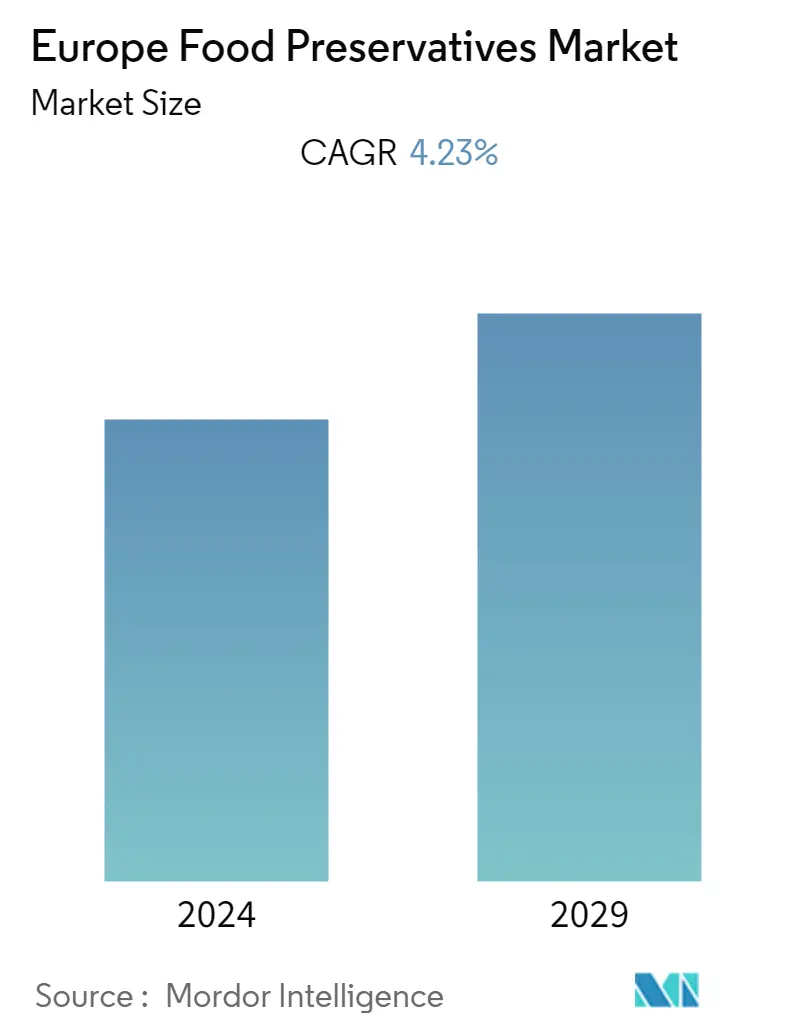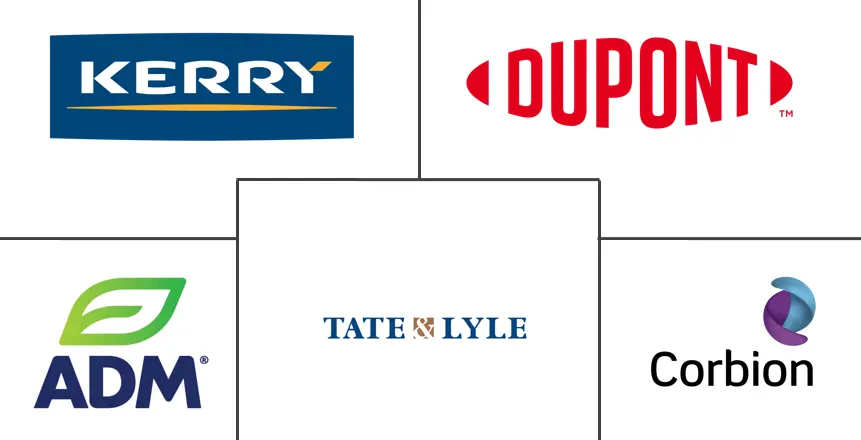Market Size of Europe Food Preservatives Industry

| Study Period | 2019 - 2029 |
| Base Year For Estimation | 2023 |
| Forecast Data Period | 2024 - 2029 |
| Historical Data Period | 2019 - 2022 |
| CAGR | 4.23 % |
| Market Concentration | Low |
Major Players
*Disclaimer: Major Players sorted in no particular order |
Europe Food Preservatives Market Analysis
Europe food preservatives market is projected to grow at a CAGR of 4.23% during the forecast period (2020-2025).
- The natural food preservatives segment is expected to record robust growth during the forecast period, particularly in the developed countries of Europe that have a large number of food companies using natural preservatives in their products.
- In addition to maintaining the quality of the food, specialty preservatives, such as sorbic acid, benzoic acid, nisin, and acetic acid, help control contamination. One group of specialty preservatives and antioxidants also prevent food from becoming rancid or developing an off-flavor.
- With the increasing acceptance of the ready-to-eat (RTE) food in Europe, manufacturers of RTE foods are inculcating clean label ingredients, which offer high nutrient and more shelf life.
Europe Food Preservatives Industry Segmentation
Europe food preservatives market is available as natural and synthetic preservatives, and by application, the market is segmented into beverage, dairy & frozen product, bakery, meat, poultry & seafood, confectionery, sauces & salad mixes, and others. The Europe market also includes data of major countries such as the United Kingdom, Spain, Germany, Italy, Russia France, and the rest of Europe.
| By Type | |
| Natural | |
| Synthetic |
| By Application | |
| Beverage | |
| Dairy & Frozen Product | |
| Bakery | |
| Meat, Poultry & Seafood | |
| Confectionery | |
| Sauces & Salad Mixes | |
| Others |
| By Geography | |
| United Kingdom | |
| Spain | |
| Germany | |
| Italy | |
| Russia | |
| France | |
| Rest of Europe |
Europe Food Preservatives Market Size Summary
The Europe food preservatives market is experiencing a dynamic shift, driven by the increasing demand for natural preservatives and the growing acceptance of ready-to-eat foods. The market is characterized by a robust growth trajectory, particularly in developed European countries where food companies are increasingly incorporating natural preservatives to enhance product quality and shelf life. Specialty preservatives such as sorbic acid, benzoic acid, nisin, and acetic acid play a crucial role in controlling contamination and preventing food from becoming rancid or developing off-flavors. The rise in popularity of on-the-go beverages and functional drinks has further fueled the demand for preservatives, as these products often require effective antimicrobial solutions to maintain their quality and safety.
The competitive landscape of the European food preservatives market is marked by the presence of both regional and global players, with companies like Koninklijke DSM N.V., Kerry Group PLC, and DuPont de Nemours, Inc. leading the charge. These companies are actively engaging in strategies such as mergers, acquisitions, and product innovations to capture market share and meet the evolving consumer preferences for natural and organic products. Despite the dominance of synthetic preservatives, there is a noticeable shift towards natural alternatives, driven by consumer awareness of the potential health impacts of synthetic additives. This trend is particularly evident in Germany, where the demand for natural preservatives is on the rise, supported by the availability of ingredients in various forms to cater to diverse food applications.
Europe Food Preservatives Market Size - Table of Contents
-
1. MARKET DYNAMICS
-
1.1 Market Drivers
-
1.2 Market Restraints
-
1.3 Porter's Five Forces Analysis
-
1.3.1 Threat of New Entrants
-
1.3.2 Bargaining Power of Buyers/Consumers
-
1.3.3 Bargaining Power of Suppliers
-
1.3.4 Threat of Substitute Products
-
1.3.5 Intensity of Competitive Rivalry
-
-
-
2. MARKET SEGMENTATION
-
2.1 By Type
-
2.1.1 Natural
-
2.1.2 Synthetic
-
-
2.2 By Application
-
2.2.1 Beverage
-
2.2.2 Dairy & Frozen Product
-
2.2.3 Bakery
-
2.2.4 Meat, Poultry & Seafood
-
2.2.5 Confectionery
-
2.2.6 Sauces & Salad Mixes
-
2.2.7 Others
-
-
2.3 By Geography
-
2.3.1 United Kingdom
-
2.3.2 Spain
-
2.3.3 Germany
-
2.3.4 Italy
-
2.3.5 Russia
-
2.3.6 France
-
2.3.7 Rest of Europe
-
-
Europe Food Preservatives Market Size FAQs
What is the current Europe Food Preservatives Market size?
The Europe Food Preservatives Market is projected to register a CAGR of 4.23% during the forecast period (2024-2029)
Who are the key players in Europe Food Preservatives Market?
Kerry Group PLC, Tate & Lyle PLC , Koninklijke DSM N.V., DuPont de Nemours, Inc. and Corbion NV are the major companies operating in the Europe Food Preservatives Market.

